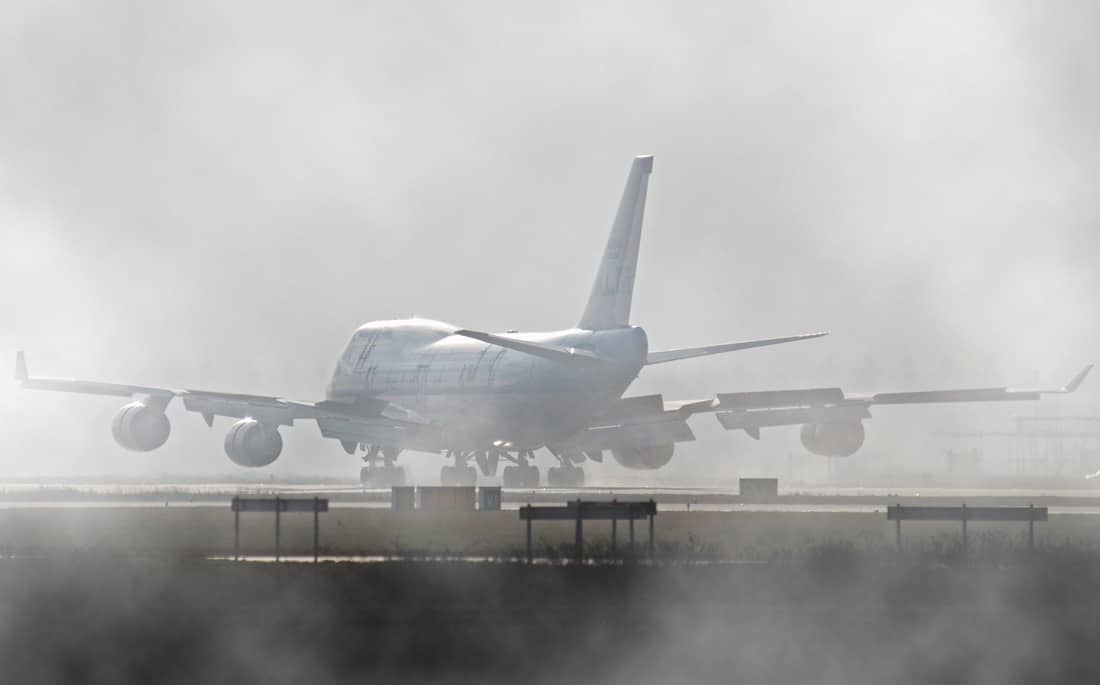Using Force Persuasion For More Effective Crew Resource Management
To err is human; to crash, unacceptable. If we know that humans inevitably make mistakes, how do we balance that idea and still keep airplanes safely in the air? While new technology and computer are great at pulling in and regurgitating input, their interpretations can be just as fallible as a pilot’s. All airline pilots have heard about Crew Resource Management (CRM). Sure, they’re given the definition, and they understand the philosophy, but to truly understand its hidden power, pilots must use the concept of “Force Persuasion” within the realm of crew resource management. This trick also works well on spouses, so use its power carefully. You’ve seen the Jedi mind trick in Star Wars, now I’m going to show you how you can use it to your benefit in the cockpit. I am gently waving my hand in front of you and telling you; you want to read what’s next…
Using the Force
The concept of Force Persuasion is simply the ability to subliminally guide another person to see the situation in a different way—your way. All those Crew Resource Management authors are cringing because we should all see it our own way, but come along with me here. My captain comes storming into the cockpit, late, discombobulated, and in a generally bad mood. Pilot are usually good about not showing emotion, but he got a speeding ticket on the way to the airport, TSA searched his flight bag because he forgot to take out his water bottle, and his wife is peeved at him because he has to miss another one of his kid’s orchestra concerts. My captain is human. My captain is a great pilot, but because he’s human, he’s reacting normally. Pilots are not normal, so you must use The Force to move his mind back into the cockpit, so he can be a pilot again. If he’s not present in our situation, he won’t be able to fully embrace the fact that the fueler mis-fueled our aircraft by topping off the wrong tanks; we are now unbalanced and overweight; we have growing cumulonimbus enroute and at our destination; and we have three MELs that are going to give us headaches. As a Force Persuasion Master, it’s easy to guide the captain back.
First, listen to his rant, nod your head, but don’t offer up examples of your own issues to join in. Sure, you have the same level of chaos going on in your own life, and your troubles are worse than his, but a Force Persuasion Master puts the issues in the cargo hold. By joining in with the rant, it’ll just get him more fired up. Just guide him back. “Hey Captain, I’m getting us something to drink. Do you want water, soda, or coffee?” I don’t ask if he wants something to drink. He needs something to break the evil spell, so I take away his choice by giving him another. “There ya go Captain, fresh, hot coffee. Hey, as you drink that, I wanted to let you know that the fuelers accidentally topped off the forward aux tanks. But, that extra fuel will come in handy because one of the MELs is the autopilot, and we have severe thunderstorms forecast at our destination. Last time we ended up holding for forty-five minutes, so if we just take off 53 bags from the forward cargo hold, we should be good to go. Or do you suggest something else?”
You’ve accomplished many things in less than ten seconds by using The Force. You’ve put him back into a pilot-state-of-mind by getting him to shift his attention to what’s in front of him, you’ve stated your concern and problems as you see it, you offered a solution, and you let him join in the decision process—and he still feels like he’s in charge. This is a simple situation that most pilots already perform daily. It’s during an emergency when someone, not necessarily the captain, needs to use The Force to see the crisis more clearly. Simply stating the anomaly you see is truly critical. But, also re-stating what is working is just as important. If you have an engine, you have a chance, even if everything else stops working. If you don’t have a working engine, let’s say over New York, but you have airspeed and a river, you have a chance. If you have no hydraulics, but two working engines, you have a chance, etc.
There is the way the cockpit should run, and the way that they sometimes run in real life. Sure, pilots have been taught crew resource management for years, we all understand the way it should be, but the reality is that there are still captains that embrace the term more fully than others while there are other captains who delegate authority too easily. Both types of captains can still be excellent aviators, but where they put their Jedi control, and on whom, can make all the difference. Let’s apply the lack of Force Persuasion to the Air France Flight 447 Airbus crash.
The Air France Flight 447 Airbus Crash
To review the scene: Airbus A-330-203. 1 hour 36 minutes into the night flight, AF447 enters area of tropical storm over the Atlantic. OAT is high and aircraft is still too heavy to climb over it. At 1 hour 51 minutes, the less experienced copilot asks, “What’s that?” The Captain replies that it’s St. Elmo’s fire. Ding! Right there, the captain should wonder why his copilot doesn’t know what St. Elmo’s fire is. He is still a young Jedi in training and can’t equate the St. Elmo’s fire with an area of disturbance in the force. Yet the captain, intent on getting his sleep, easily delegates his control onto nothing. He forgets to hand it over to the next Jedi in charge so he takes The Force with him to sleep. Just because a pilot is at the controls, doesn’t mean they’re in control. And so it begins…
02:02: The second copilot, fresh from his scheduled onboard rest, comes into the cockpit. The captain does not delegate authority to anyone in particular. He just gets up, and the senior copilot sits in the captain’s seat while the less experienced, less senior copilot stays the flying pilot. Even if the captain wasn’t concerned about the storm, a Force Persuasion Master would care about where their control goes when they leave the cockpit. The control left with the captain. He could have simply stated to the crew that since the copilot coming on duty was fresh from a break, he would turn his control over to him, but let the flying copilot remain the flying pilot. It would still trigger the nonflying copilot to step into the leadership role, even though the other pilot was in charge of the flight controls. Within 15 minutes of the captain leaving, they would all be dead. If they had used The Force wisely, you might not have had to read the following sequence (overview, not exhaustive transcript):
02:03: Copilots both realize they are heading into a storm and tell lead flight attendant to be prepared.
02:06: They turn on airframe anti-icing, decreasing engine performance (but still the correct decision).
02:07: Nonflying, more experienced, more senior copilot (NFCP), sitting in captain’s seat, realizes radar was not set in correct mode and it suddenly dawns on him they are headed into the belly of the storm.
02:08: Flying, less experienced copilot (FCP) says, “You can possibly pull it a little to the left.” (French to English translation)
02:08: NFCP: “Sorry, what?”
02:08: FCP: “You can possibly pull it a little to the left. We’re agreed that we’re in manual, yeah?” I’m not sure what he means, but there is no further discussion.
At this point, the plane banks to the left. The FCP comments about a strange smell and thinks something is wrong with the air conditioning. The nonflying, more experienced copilot assures him that it is an effect of the severe weather in the area. There is then a different sound, presumably the tapping and accumulation of ice crystals. The FCP asks the more experienced copilot if he should turn on engine anti-ice.
Then, an alarm sounds for 2.2 seconds. The autopilot is disconnecting because the pitot tubes have iced over. At this point, the more experienced copilot should use his Jedi skills and state: “Autopilot is disconnecting, remain the flying pilot. The issue is the autopilot and I also see an unusual indication in the airspeed, which is probably why the autopilot disconnected. EPR settings and oil pressure appear normal. Keep flying, but what could be the reason why the airspeed is changing if no other parameters have been changed.” It takes just five seconds to use Force Persuasion to evaluate changes, state the anomaly, and verify who has control without delegating control. Just because you’re flying the airplane, doesn’t mean you have control.
The airplane then climbs at 7,000 fpm, and then descends, all while “Stall!” is blaring 75 times by the warning system. Neither pilots talks about why it’s screaming “Stall!”
02:10: One of the pitot tubes begins to work again and display properly, but the flying pilot ignores it and continues to climb and descend erratically. The NFCP still does not take over and decides to ring for the captain. At this point, both pilots are probably not wanting to touch anything until the captain gets there.
02:10: The flying copilot is now within an acceptable flying envelope, but for some reason increases back pressure, raising the nose and bleeding off speed, again. Both pilots ignore it. The aircraft is in “alternate law” which is another story, but both pilots don’t believe they can actually stall this airplane so they ignore the stall warnings.
02:10: Another pitot tube begins to function again. The avionics are now all functioning normally. From here on out, it’s all pilot error:
02:11: Flying copilot: “I’m in TOGA, huh?” He has stated his erroneous conclusion – and the other pilot does not reply. If the flying pilot thinks this is like a go-around situation, he is trained to increase power to the TOGA level and raise the nose to a certain pitch angle – which is usually done closer to sea level. They’re at 38,000 feet so the same angle of pitch will be deadly here. It might explain why the flying copilot instinctually holds back pressure on the stick up to the moment of the crash.
02:11: The senior nonflying copilot: “We still have the engines! What the hell is happening? I don’t understand what’s happening.” Oh, he almost had it. WE STILL HAVE ENGINES. The Force was trying to work through him. He said the magic words. A Force Persuasion Master would say, “We still have engines. Let go of the stick for a moment and let the airplane speak.” The irony is that the airplane would probably stabilized itself if not given erroneous input from the pilot.
02:11: The flying copilot states, “Damn it, I don’t have control of the plane, I don’t have control of the plane at all!” “Left seat taking control” is the reply. This is the moment where the other, more senior copilot takes over while the captain comes back in the cockpit. The moment the captain comes in, the flying pilot is still letting control come from the captain rather than within.
02:11: (The senior copilot is now at the controls) Captain says, “What the hell are you doing?” Good question, but bad question because you’ll get nothing but bad answers. FCP responds, “We’ve lost control of the plane!” NFCP backs him “We’ve totally lost control of the plane. We don’t understand at all. We’ve tried everything.”
Force Master Captain should say “What is not working?” to which they would have to reply, “Everything is working, except that indications say we are stalling. Engines and flight controls are working.”
The aircraft at this time is pitched 15 degrees with forward speed of 100 knots, at an angle of 41.5 degrees and descending at the rate of 10,000 feet per minute on the back side of the power curve – with a fully functioning engine power system. They actually get airspeed below 60 knots so the stall-warning stops.
02:12: “What do you think? What do you think? What should we do?” Captain replies, “Well, I don’t know!” He does know, because the computer is yelling at him to recover from the stall. They are approaching 10,000 feet over a very dark ocean so without quick visual reference, they might not acknowledge how little distance they have, and if this was daytime, they would have seen the unusual pitch attitude of the airplane. The plane is in “dual input” mode and the nonflying copilot still has his hand on the stick chanting in his mind, TOGA, TOGA, TOGA while pulling back. The system averages his inputs with the left seat’s input and the flying pilot has no idea the copilot is still putting back pressure on the controls.
02:13: “Climb…climb…climb…climb…”chants the flying pilot. “But, I’ve had the stick back the whole time” is the copilot’s reply. DING! The Captain, who has just been observing, suddenly gets the severity of the problem. “No, no, no…Don’t climb! No, no,” replies the captain. The flying pilot responds, “Descend, then, give me the controls. Give me the controls!” The copilot FINALLY releases his hand from the stick, but they are at 2,000 feet and since they are rapidly approaching the ocean, a new alarm sounds. When the new alarm sounds, the less experienced copilot, with TOGA vision, reflexively and secretly pulls back on the stick again. He seals their fate. There is no time to recover.
02:14: “Damn it, we’re going to crash. This can’t be happening.”1
Final Thoughts on Force Persuaion and Crew Resource Management
Pilots can forget to use Force Persuasion and unfortunately, it can also be used for the Dark Side. “Ummm Captain…I don’t think we have clearance for takeoff.” “I’m sure we do, copilot. You want to question me during your line-check. That’s fine. Go ahead.” Yes, the words are correct, but the tone is the menace and would disarm most junior copilots. Social construct overrides doubt for a junior pilot, no matter how much they understand crew resource management. In this situation, the junior Jabba the Hutt copilot would say to himself, “Your mind powers will not work on me.” And then, he’d call tower to verify takeoff clearance.
In an aviation era where we are continuously taught collaboration, and to make decisions as a team, we have somewhat fallen away from the intrinsic and unspoken need to still have someone, not necessarily the captain, “present” and in charge in the cockpit. The captain still has the final say, but I’ve thankfully seen many cockpits where the copilot is quietly controlling the flight because the captain was just too human on that particular day. It works, even if the books say it shouldn’t. No matter which seat you’re in, there will be days where you are more in control of understanding a situation, so there is a need to teach pilots how to communicate better when they are not directly handed control. Even if you are a lowly copilot, you can still be in command of your own Force Persuasion.
Footnote:
1 – Translated, NTSB. (2009, June 1). Air France 447. Retrieved January 26, 2015, from //www.planecrashinfo.com/cvr090601.htm















As one of those “CRM Authors”, I have thoroughly enjoyed your article Erika! I will make sure to make a mention of this Jedi Mind Trick in my upcoming courses! 🙂